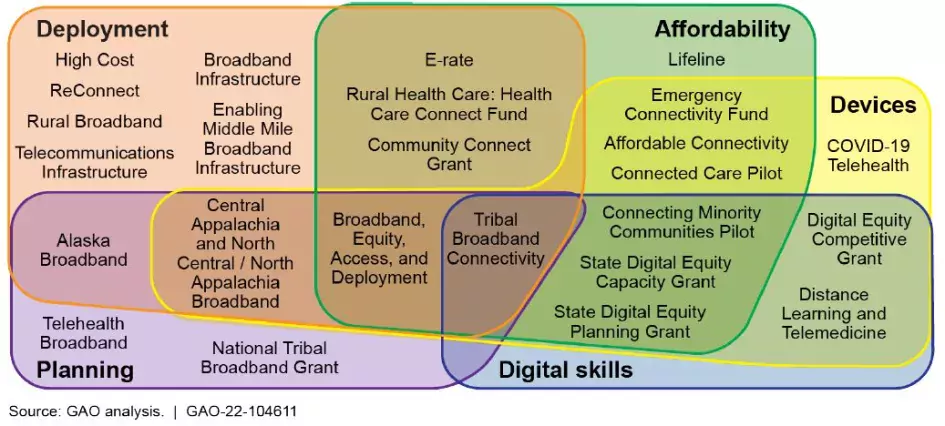Communities Rely on Federal Grants, But May Have Challenges Accessing Them
Federal funding through grants has a great impact on the communities we live in. They help pay to pave roads, support students’ tuition and other college costs, buy food for families needing assistance, clean up after natural disasters, and more.
This funding—along with other federal aid programs—totaled $1.2 trillion last fiscal year and plays an important role supporting everyday life in communities across the country. Federal grants are also used to fund national priorities, such as responding to COVID-19
So why do communities find them difficult to access?
Today’s WatchBlog post looks at federal grant oversight and access issues. Last month, GAO’s Jeff Arkin, an expert on federal grant programs, testified before Congress about the challenges communities may face in accessing grants meant to help them. To watch the full congressional hearing on federal grants management, click here.
What are the challenges and what could improve communities’ experiences?
While grants are an important source of funds for community needs, state and local governments and organizations can face barriers to obtaining and effectively managing this funding. This is especially true for communities facing a financial crisis.
Following a loss of population and industries as well as a decrease in state revenue, the City of Flint, Michigan, fell into a severe financial crisis during the last decade. Flint did not have the local resources needed to make the city competitive for federal grants to support infrastructure maintenance and improvement projects and, as a result, did not apply for much needed assistance.
Communities may also have challenges navigating the wide range of federal grant programs that span across many federal agencies. Some of the programs even result in duplicative or overlapping federal support, which also can create difficulties for communities attempting to obtain federal grants. For example, we found 25 federal programs aimed at expanding access to high-speed internet, known as broadband. The volume of programs has caused challenges for potential recipients to navigate. We recommended ways that federal efforts could be streamlined to help areas without broadband, such as rural, Tribal, and other underserved communities, access funding.
The Mosaic of 25 Federal Programs with Broadband as a Main Purpose and Their Overlap
Image

If a community is able to successfully navigate the grant process and get a grant, they may also struggle to manage this funding. Communities that receive federal grants must administer them as stipulated by the federal agencies that award them, and in the case of economic development grants, often must conduct additional strategic planning efforts. For example, in 2021, we found that communities that receive economic development grants from more than one agency face greater administrative and planning burdens than if they were to receive grants from only one agency. Agency coordination could reduce the administrative and planning burden on the grantees.
The federal government could help mitigate these and other challenges local communities face by providing technical support and covering the cost of administering the grant. The federal government could also continue trying to reduce burdens on communities by coming up with new ways to streamline grants management at agencies.
The federal government has taken some steps to streamline grants management and reduce the burden on communities. For example, in response to the Grant Reporting Efficiency and Agreements Transparency Act of 2019 (GREAT Act), federal agencies are working on efforts to reduce of burden and compliance costs faced by recipients of federal grants. But more action is needed to ensure funding is monitored and that there is transparency in its use.
What could improve oversight and transparency of funding?
A lack of transparency and oversight also contributes to federal funding challenges. For example, we have identified challenges related to the timeliness, completeness, and accuracy of grant data on USAspending.gov, the federal government’s official source for spending data. Likewise, we have identified challenges with the completeness and accuracy of subaward information provided on USAspending.gov.
To address these issues, we have made recommendations to the Office of Management and Budget (OMB) and the Department of the Treasury on ways to improve the quality of information provided on USAspending.gov. The agencies have taken some steps toward implementing them.
Federal grant money overseas
Not all federal grant money is spent within the United States. Federal agencies sometimes provide grant funding to recipients in foreign countries to advance U.S. interests abroad. Similar to grants within the U.S., these international grants also experience oversight and transparency challenges. For instance, from fiscal year 2017-2021, the U.S. provided at least $48 million to research institutions, companies, and other recipients located in China. But the full extent of this funding remains unclear because the data tracking subawards is incomplete and sometimes inaccurate. Greater transparency of grant spending can help Congress and the public understand how and where federal grant funds are spent.
Listen to our recent podcast with GAO’s Kim Gianopoulos, an expert on U.S. foreign investments, to learn more about federal funding in China.
Our work has shown that effective oversight of federal grants is important because it can provide reasonable assurance to Congress, federal managers, and taxpayers that grants are awarded and used properly. Grants are part of our everyday lives and their transparency and oversight is important. To learn more about our work on federal grants visit our key topics page on grants.
- Comments on GAO’s WatchBlog? Contact blog@gao.gov.






